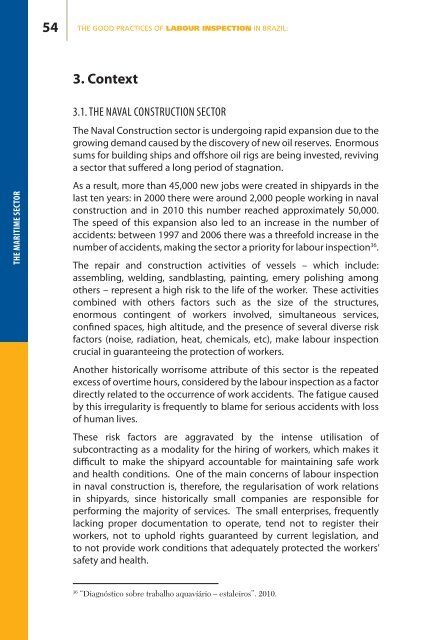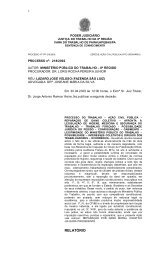The Maritime Sector
The Maritime Sector
The Maritime Sector
Create successful ePaper yourself
Turn your PDF publications into a flip-book with our unique Google optimized e-Paper software.
54THE GOOD PRACTICES OF LABOUR INSPECTION IN BRAZIL:3. ContextTHE MARITIME SECTOR3.1. THE NAVAL CONSTRUCTION SECTOR<strong>The</strong> Naval Construction sector is undergoing rapid expansion due to thegrowing demand caused by the discovery of new oil reserves. Enormoussums for building ships and offshore oil rigs are being invested, revivinga sector that suffered a long period of stagnation.As a result, more than 45,000 new jobs were created in shipyards in thelast ten years: in 2000 there were around 2,000 people working in navalconstruction and in 2010 this number reached approximately 50,000.<strong>The</strong> speed of this expansion also led to an increase in the number ofaccidents: between 1997 and 2006 there was a threefold increase in thenumber of accidents, making the sector a priority for labour inspection 36 .<strong>The</strong> repair and construction activities of vessels – which include:assembling, welding, sandblasting, painting, emery polishing amongothers – represent a high risk to the life of the worker. <strong>The</strong>se activitiescombined with others factors such as the size of the structures,enormous contingent of workers involved, simultaneous services,confined spaces, high altitude, and the presence of several diverse riskfactors (noise, radiation, heat, chemicals, etc), make labour inspectioncrucial in guaranteeing the protection of workers.Another historically worrisome attribute of this sector is the repeatedexcess of overtime hours, considered by the labour inspection as a factordirectly related to the occurrence of work accidents. <strong>The</strong> fatigue causedby this irregularity is frequently to blame for serious accidents with lossof human lives.<strong>The</strong>se risk factors are aggravated by the intense utilisation ofsubcontracting as a modality for the hiring of workers, which makes itdifficult to make the shipyard accountable for maintaining safe workand health conditions. One of the main concerns of labour inspectionin naval construction is, therefore, the regularisation of work relationsin shipyards, since historically small companies are responsible forperforming the majority of services. <strong>The</strong> small enterprises, frequentlylacking proper documentation to operate, tend not to register theirworkers, not to uphold rights guaranteed by current legislation, andto not provide work conditions that adequately protected the workers’safety and health.36“Diagnóstico sobre trabalho aquaviário – estaleiros”. 2010.
















